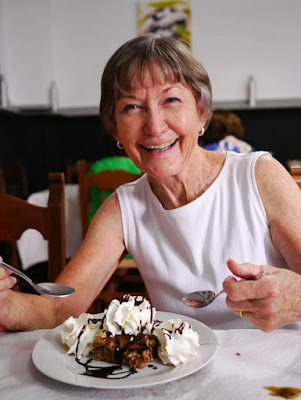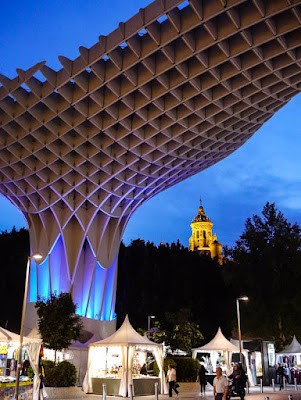
We watched the sun set from San Nicolas plaza in the Albayzín while checking out all the sights.

The left-handed guitar player was also a good singer.

We visited Granada to see the Alhambra. The name Alhambra comes from the Arabic word Al-Ḥamrā meaning literally the red one. The walls of the Alhambra at sunset seem to glow red.

Our apartment was near Sacromonte, so we walked around this district that is known as where the Romanies or gypsies settled. They built directly into the hillside and used caves to make their homes.

This building is decorated with plates and flowerpots and a sign that says, “Gitanos”, the Spanish term for Romanies.

The view from Sacromonte up to the Alhambra was great.

We watched a flamenco performance and were awed by the intensity of the music and dance.

We learned that flamenco is an Andalusian art form rather than strictly Gitano, although there are many Gitanos who are flamenco artists.
We made a short movie of the performance - click here if you want to watch.

Granada was controlled by the Muslim kings of Spain starting in the 8th century. The name originally was Ġarnāṭah in Arabic. Granada means pomegranate in Spanish.

The city has embraced the fruit as its symbol, and there are pomegranates on fountains and buildings.

There are even pomegranates on the traffic barriers that line the sidewalks here.

This graffiti mildly opposes the symbol saying, "There are no pomegranates here, only people from Granada."

This is the Gate of the Pomegranates on the road up to the Alhambra. There are three fruits on top of the gate.

We spent two days visiting the Alhambra. Patty and Bill made comments about how steep the road up to the Alhambra was, but they were way ahead of us!

The oldest part of the Alhambra is the alcazaba or fortress. Initially built in the 7th century, first there was only the fortress with its imposing towers, gates and walls.

Here we are in the oldest part of the Alhambra.

Patty and Pete wanted to explore all of the alcazaba, even the parts that were off-limits.

We climbed up and down the towers through small staircases.

And we enjoyed the views of Granada. Kristina is pointing to where our Airbnb apartment is roughly located.

Pete loves to take photographs, and at the Alhambra he found a new subject: he takes photos of people taking selfies. This is the best one he took this day.

Kristina and Patty are in front of the portico and pool, which are all that remain of this early 14th-century palace. Both mother and daughter celebrated big birthdays this year, with Patty turning 75 and Kristina turning 50 - so we call our trip the 50/75 tour!

It was emir Mohammed ben Al-Ahmar who built the first palaces and mosques of the Alhambra. He had an eight kilometer canal built to bring water from the Darro river to the Alhambra.

Water is a central feature in the Alhambra. We noticed a dozen frogs on the lily pads in this pool.

Water enables the spectacular gardens of the Alhambra.


And the courtyards are filled with fountains and beautiful plants.

The Generalife palace was built away from the main Alhambra palaces, as a retreat for the royal family. The gardens are beautiful and cool, thanks to the water features and hilltop breezes.


Bill looks like he’s making a top secret call while sitting on the porch of the Generalife, but he’s actually listening to the informative audio guide.

The Generalife has primarily white walls, so it looks very different from the rest of the Alhambra.

For over 250 years the Nasrid dynasty ruled Granada and beyond from the Alhambra. This is the Court of Myrtles. The pond shows the reflection of the palace, making the building appear even larger.

The Court of the Lions is named for the central fountain with 12 marble lions supporting an alabaster fountain.

There are 124 white marble columns in the courtyard that are connected by Nasrid arches that are adorned with stucco.

The stucco work at the Alhambra is staggeringly elaborate. It’s interesting to see how such a simple, inexpensive material has lasted almost 1,000 years.

This dome is honeycombed stucco called "stalactite vaulting”.

The walls are often covered in detailed stucco that was originally painted or gilded. Islamic art isn’t figurative, instead it uses patterns and Arabic words.


The arch between Kristina and Patty is called herradura from the Arabic word for horseshoe.

The arches repeat throughout the Alhambra, as niches, doorways and windows.



The glazed, ceramic tiles are called azulejos.

Azulejos often cover the lower part of the walls in the Alhambra palaces.

We found the complex geometric patterns very pleasing to look at.

Kristina is showing her new glasses case and fan with an Alhambra motif.

On our way back down to Granada Patty stopped by the statue of Washington Irving. We read from his Tales of the Alhambra to learn more about this fascinating place.

We were very hungry after all the walking around, so we had a big lunch. On the table are delicious meatballs, tomato salad and braised oxtail.

We tried this special salad from Granada made with oranges, cod, red peppers, onions and olives.

And our favorite was the smoked fish platter with lox, cod, anchovies and caviar.

Can you believe we had room for dessert? Kristina has walnut ice cream dipped in chocolate, Patty has raspberry ice cream dipped in chocolate, and we're not sure what Bill has but he asked for spumoni.

We could have stayed longer in fascinating Granada, but we wanted to visit Sevilla too. Here we are in the old quarter of Sevilla enjoying coffee and crepes.

Pete couldn't resist mirroring the statue in this fountain.

We visited the Sevilla Cathedral, which is massive but not as ornate as the cathedral in Toledo.

We can understand why it took 100 years to build!

We climbed to the top of the Giralda tower. Originally built in the 12th century as a minaret for a mosque, it was made taller to become the Cathedral's bell tower. Giralda is almost 100 meters tall and is the highest point in Sevilla.

Patty is holding one of the impressive door knockers at the cathedral.

We went to the Real Alcázar, or the Royal House of Seville. The main entrance is through the Lion Gate.

This is the Courtyard of the Maidens, which was built originally in the 11th century. The top story and modifications in a Renaissance style were ordered by Charles V in the 16th century.

Here's Pete's favorite photo of other people taking selfies for this day. Kristina is not photo-bombing their selfie!

This is an underground swimming pool that was built to help the royal family keep cool in the summertime. Sevilla is nicknamed "the frying pan of Spain" because it gets so hot here. Fortunately we had cool weather.

We enjoyed the gardens at the Real Alcázar the most. This spectacular orchid tree was in full bloom.

The gardens are separated by gates decorated with ceramic tiles.

On the left are balconies for strolling while looking out at the extensive gardens.

The decorative stucco work inside the Real Alcázar is not as well-preserved as it is in the Alhambra.

But the azulejos, ceramic tiles, are striking.

Did we mention that the desserts throughout Spain have been delicious? Patty is enjoying her chocolate tart, and she did share it with all of us!

We stayed in a villa just outside of Sevilla. This beautiful home (through Airbnb) was our splurge so we could spend time relaxing with Patty and Bill.

The entryway and upstairs have beautiful azulejos.

The pool and patio are wonderful. We swam most days.

We enjoyed hanging out and reading in the living room.

And Bill mastered the art of the siesta. We think he became a bit Spanish on this trip, so perhaps we should call him Guillermo now.

After a day of hanging out at the villa, we were rested enough for another day of sightseeing. We went to the Roman ruins of Italica, a city founded in 200 BC. This is the coliseum, which could hold 20,000 spectators in its heyday. We thought is was interesting that Italica had only 8,000 residents.

We were able to walk through the coliseum stands. Pete is crouched in what appears to be a window that lets light onto the staircase behind.

Bill and Patty are climbing down from stairs that lead to the second floor stands in the coliseum.

In the residential part of Italica, there are a number of mosaic floors that remain. It was a treat to explore the ancient ruins.

Bill took us to a memorable meal at Restaurante Navarro where we ate a lot.

These piquillo peppers were stuffed with tuna and shrimp and covered in a creamy sauce.

This is Lomo Navaro, the restaurant's special pork fillets that are served with an artichoke sauce and topped with jamón iberico.

The four of us shared almond tart and flan desserts. All too soon our two weeks together were over, but we had a wonderful time! Patty and Bill are continuing on to Barcelona for a few days.

And we stayed in Sevilla. We went to Plaza de España. Here are the historical tiles for Barcelona that show Christopher Columbus returning from the Americas with Native Americans to show to King Ferdinand and Queen Isabella.

The Plaza de España in Sevilla is spectacular.

It's adorned with countless ceramics.

It was built in 1929 for the world's fair.


Renovations in 2006 have restored the ceramics to their original beauty.

The tapas bar we chose for lunch had ajo blanco, the same type of soup we had learned to make in Málaga so we had to order it.

Patty would have loved their chocolate mousse dessert!

We walked across the Isabella bridge to the Triana neighborhood.

Known for making ceramics, we first saw a bench with tiles of the bridge.

We enjoyed the ceramics museum.

The museum is housed in an old ceramics factory, where the modern 2nd story rises above the old kilns.

The window decorations are ceramic tubes.

In the Altozano Plaza there was this intriguing sculpture of a famous bullfighter named Belmonte.

Sevilla is such an interesting city. We loved walking around and exploring the neighborhoods. This corner is called the door of meat (we don't know why), and Kristina couldn't resist using her fan as is the woman on the tiles.

There are very few modern buildings, so Espacio Metropol Parasol stands out. It's also called las setas, the mushrooms, because of the shape of the towers.

The upper story felt like a roller coaster as we walked up and down the curvy ramps.

Build of birch with metal fasteners, it claims to be the largest wooden building in the world.

At night it's nicely lit. We liked the contrast of the old church with the iconic Metropol.

Sevilla is so beautiful at night. We have enjoyed our time here!

Next we will visit Córdoba on our way back to Madrid.